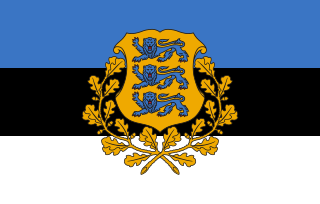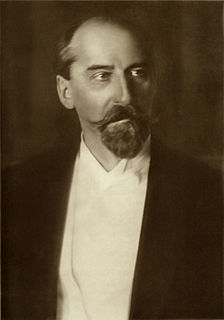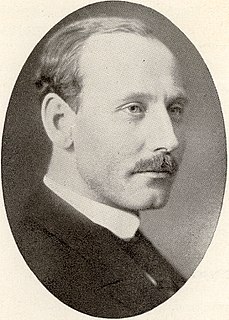Politics in Estonia takes place in a framework of a parliamentary representative democratic republic, whereby the Prime Minister of Estonia is the head of government, and of a multi-party system. Legislative power is vested in the Estonian parliament. Executive power is exercised by the government, which is led by the prime minister. The judiciary is independent of the executive and the legislature. Estonia is a member of United Nations, the European Union, and NATO.

Otto August Strandman was an Estonian politician, who served as Prime Minister (1919) and State Elder of Estonia (1929–1931). He was one of the leaders of the centre-left Estonian Labour Party, that saw its biggest support after the 1919 and 1920 elections. Strandman was a key figure in composing the radical land reform law and the 1920 Constitution. He also served as Minister of Agriculture (1918–1919), Minister of Justice, Minister of Finance (1924), Minister of Foreign Affairs and Minister of War (1919). While he was in the office of Minister of Finance, he stabilized the economy and managed to avoid hyperinflation. Strandman was also the speaker of both the Estonian Provincial Assembly (1917–1918) and Riigikogu (1921). He was a diplomat, serving as an envoy in Warsaw (1927–1929), when he made contacts with Polish politicians, and in Paris (1933–1939). During the Soviet Occupation in 1941, Strandman was ordered to show up to the NKVD headquarters. Already knowing about his fate, he committed suicide in his home in Kadrina.

The Prime Minister of the Republic of Turkey was the head of government of the Republic of Turkey from 1920 to 2018, who led a political coalition in the Turkish Parliament and presided over the cabinet. Throughout the political history of Turkey, functions and powers of the post have changed occasionally.

The prime minister of Estonia is the head of government of the Republic of Estonia. The prime minister is nominated by the president after appropriate consultations with the parliamentary factions and confirmed by the Parliament. In case of disagreement, the Parliament can reject the president's nomination and choose their own candidate. In practice, since the prime minister must maintain the confidence of Parliament in order to remain in office, they are usually the leader of the senior partner in the governing coalition. The current prime minister is Kaja Kallas of the Reform Party. She took the office on 26 January 2021 following the resignation of Jüri Ratas.

Konstantin Päts was the most influential politician of interwar Estonia, and served five times as the country's head of government. He was one of the first Estonians to become active in politics and started an almost 40-year political rivalry with Jaan Tõnisson, first through journalism with his newspaper Teataja, later through politics. He was condemned to death during the 1905 Revolution, but managed to flee first to Switzerland, then to Finland, where he continued his literary work. He returned to Estonia, but had to spend time in prison in 1910–1911.

The president of the Republic of Estonia is the head of state of the Republic of Estonia. The current president is Alar Karis, elected by Parliament on 31 August 2021, replacing Kersti Kaljulaid.

Jaan Tõnisson was an Estonian statesman, serving as the Prime Minister of Estonia twice during 1919 to 1920, as State Elder from 1927 to 1928 and in 1933, and as Foreign Minister of Estonia from 1931 to 1932.
Riigihoidja was the name of the office of the head of state and head of government of Estonia from 3 September 1937 to 24 April 1938. The only person to hold this position was Konstantin Päts, five time former State Elder. His eventual successor ex officio was Johan Laidoner, then Commander-in-Chief.

Kaarel Eenpalu was an Estonian journalist, politician and head of state, who served as 7th Prime Minister of Estonia.
Constitution of Estonia is the fundamental law of the Republic of Estonia and establishes the state order as that of a democratic republic where the supreme power is vested in its citizens. The first Constitution was adopted by the freely elected Estonian Constituent Assembly on 15 June 1920 and came into force on 21 December 1920. Heavily amended on 24 January 1934, following a referendum in 1933, it was in force until the second Constitution was enacted on 1 January 1938. It remained in force, de facto, until 16 June 1940, when the Soviet Union occupied Estonia and, de jure, until 28 June 1992, when the fourth and current Constitution of the Republic of Estonia was adopted by referendum.
History of Estonia from 1920 to 1939 spanned the interwar period from the end of the Estonian War of Independence until the outbreak of World War II and covers the years of 1) parliamentary democracy 2) the Great Depression and 3) the period of authoritarian rule.

The Estonian government-in-exile was the formally declared governmental authority of the Republic of Estonia in exile, existing from 1944 until the reestablishment of Estonian sovereignty over Estonian territory in 1991–92. It traced its legitimacy through constitutional succession to the last Estonian government in power prior to the Soviet invasion of 1940. During its existence, it was the internationally recognized government of Estonia.
The Era of Silence was the period between 1934 and 1938 in Estonian history. The period began with the preemptive self-coup of 12 March 1934, which the then Prime Minister Konstantin Päts carried out to avert a feared takeover of the state apparatus by the Vaps Movement. The term "era of silence" was introduced by Kaarel Eenpalu, Prime Minister in 1938–39 and a strong supporter of Päts, Estonia's President during that period.

Estonianization or Estonianisation is the changing of one's personal names from other languages into Estonian, or the development of Estonian language, culture and identity within educational and other state institutions through various programs.
Corporate chambers were a series of corporate institutions in Estonia during the interwar period. The first of these – the Chamber of Commerce and Industry – was created in 1924, and the second, the Chamber of Agriculture, followed in 1931. However, most of the chambers were established after the 1934 coup d'état of Konstantin Päts, and the Era of Silence which followed the coup became their heyday.
The Estonian Labour Party was a political party in Estonia. It was formed in 1919 by a merger of the Radical Socialist Party and the Social Travaillist Party, and ceased to exist in 1932, when it merged with other centrist parties to form the National Centre Party. It was a member of government coalitions between 1919 and 1925, and again from 1927 until 1931.

Linda Marie Eenpalu was an Estonian politician. She was a member of the National Constituent Assembly (1937) and a Member of the Second Chamber of the National Council (1938) and the first of her gender in both of these positions. She was a well-known women's rights activist. She was married to politician Kaarel Eenpalu, who was prime minister in 1938–39.
The Estonian Socialist Workers' Party was a political party in Estonia.
The Union of Settlers and Smallholders was a political party in Estonia.


















